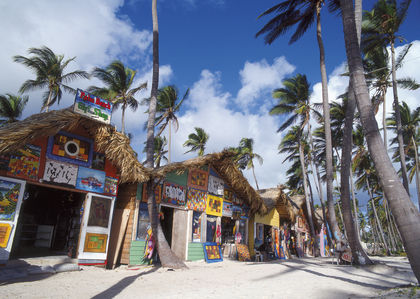DOMINICAN REPUBLIC

Dominican Republic
Republica Dominicana
CAPITAL : Santo Domingo
FLAG : The national flag, adopted in 1844, consists of a white cross superimposed on a field of four rectangles, the upper left and lower right in blue, the upper right and lower left in red.
ANTHEM : Himno Nacional, beginning "Quisqueyanos valientes, alcemos nuestro canto" ("Valiant Dominicans, let us raise our song").
MONETARY UNIT : The Dominican peso ( RD $) of 100 centavos is a paper currency. There are coins of 1, 5, 10, 25, and 50 centavos and 1 peso, and notes of 1, 5, 10, 20, 50, 100, 500, and 1,000 pesos. RD $1 = US $0.0421 (or US $1 = RD $23.75) as of May 2003.
WEIGHTS AND MEASURES : The metric system is the legal standard, but US and Spanish weights are widely used in commercial transactions.
HOLIDAYS : New Year's Day, 1 January; Epiphany, 6 January; Altagracia Day, 21 January; Duarte Day, 26 January; Independence Day, 27 February; Labor Day, 1 May; Restoration of Independence, 16 August; Day of Our Lady of Las Mercedes, 24 September; All Saints' Day, 1 November; Christmas, 25 December. Movable religious holidays include Good Friday and Corpus Christi.
TIME : Eastern Daylight Savings Time is maintained throughout the year; 8 AM = noon GMT.
ETHNIC GROUPS
Ethnic divisions have been estimated at 16% white, 11% black, and 73% mulatto. Descendants of early Spanish settlers and of black slaves from West Africa constitute the two main racial strains.
LANGUAGES
Spanish is the official language. Some English is spoken in the capital, and a Creole dialect is used along the Haitian border.
ARMED FORCES
Active armed forces in the Dominican Republic number 24,500 personnel. The army of 15,000 is organized into 4 infantry brigades. The air force has 5,500 personnel and is equipped with 16 combat aircraft. The navy of 4,000 operates 15 coastal defense ships. The national police numbers 15,000. In 1998, the armed forces were allocated $180 million or about 1.1% of GNP.
FORESTRY
About 28.4% of the total land area consisted of forests and woodlands in 2000. Roundwood production in 2000 totaled 562,000 cu m (19.8 million cu ft). Virtually all the timber cut is for land clearing and fuel.
SCIENCE AND TECHNOLOGY
The Dominican Medical Association and the Dominican Sugar Institute have their headquarters in Santo Domingo. Ten colleges and universities offer degrees in engineering, basic sciences, medicine, and agriculture. In 1987–97, science and engineering students accounted for 35% of college and university enrollments.
DEPENDENCIES
The Dominican Republic has no territories or colonies.
BIBLIOGRAPHY
Baud, Michiel. Peasants and Tobacco in the Dominican Republic, 1870–1930. Knoxville: University of Tennesee Press, 1995.
Chester, Eric Thomas. Rag-Tags, Scum, Riff-Raff, and Commies: The U.S. Intervention in the Dominican Republic, 1965–1966. New York: Monthly Review Press, 2001.
Dominican Republic and Haiti: Country Studies. 2nd ed. Washington, D.C.: Library of Congress, 1991.
Grasmuck, Sherri, and Patricia R. Pessar. Between Two Islands: Dominican International Migration. Berkeley: University of California Press, 1991.
Health in the Americas, 2002 edition. Washington, D.C.: Pan American Health Organization, Pan American Sanitary Bureau, Regional Office of the World Health Organization, 2002.
Metz, Helen Chapin, ed. Dominican Republic and Haiti: Country Studies . Washington, D.C.: U.S. Government Printing Office, 2001.
Moya Pons, Frank. The Dominican Republic: A National History. New Rochelle, N.Y.: Hispaniola Books, 1995.
Pacini Hernandez, Deborah. Bachata: A Social History of a Dominican Popular Music. Philadelphia: Temple University Press, 1995.
Palmer, Bruce. Intervention in the Caribbean: the Dominican Crisis of 1965. Lexington, Ky.: University Press of Kentucky, 1989.
Safa, Helen Icken. The Myth of the Male Breadwinner: Women and Industrialization in the Caribbean. Boulder, Colo.: Westview Press, 1995.
Schoenhals, Kai P. Dominican Republic. Santa Barbara, Calif.: Clio Press, 1990.
Wiarda, Howard J. and Michael J. Kryzanek. The Dominican Republic, a Caribbean Crucible, 2nd ed. Boulder, Colo.: Westview Press, 1992.